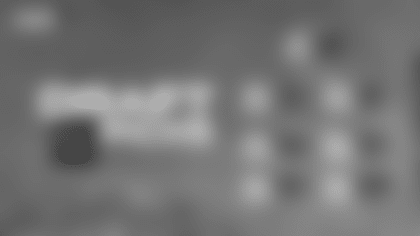ENGLEWOOD, Colo. --There are few certainties and surprises. But if the Broncos take the best player available at each time they're on the clock during the draft, it seems certain that none of the picks the first two days will be used on a quarterback.
But on Day Three? If there's someone they like, it wouldn't be out of the realm of possibility to see a late pick used on a quarterback.
Each week, we'll look at players at each position in Denver's potential range. Today, it's the quarterbacks:
Tajh Boyd, Clemson: His height (6-foot-1) and a slower-than-expected 40 time at the Combine (4.84 seconds, seventh-best among quarterbacks) work against him, as does the perception that his success was a product of elite receivers, specifically 2013 first-rounder DeAndre Hopkins and likely high 2014 pick Sammy Watkins. But he improved his accuracy every year of his college career (to a completion percentage of 68.5 percent by last year), leads his receivers well and has a quick delivery. A potential high value pick.
David Fales, San Jose State: A solid Senior Bowl week helped Fales begin answering questions over whether he was simply a product of a quarterback-friendly offense. Fales doesn't have a cannon, but displays good touch and knows when to throw fastballs and when to take some zip off of his throws.
Jordan Lynch, Northern Illinois: "I'm a quarterback first," Lynch maintained at the Combine. "I always say I'm a quarterback first, and I've been proving people wrong ever since I started playing." But he said if he had to switch, he'd like to play running back or slot receiver. One factor working against him no matter his offensive position are his small hands; they measured at 8 7/8 inches, the smallest of any quarterback at the Combine. But when he ran in college, he displayed good vision and change of direction.
Jeff Mathews, Cornell: Mathews doesn't have enough speed to be considered a mobile quarterback (5.26 40 time at the Combine), but his size, arm strength and accuracy more than compensate. He can throw to all areas of the field, has ideal size (6-foot-4, 223 pounds) and the third-biggest hands of any quarterback at the Combine.
Stephen Morris, Miami (Fla.): Morris is quick and athletic, but his accuracy is cause for concern; in two seasons as the Hurricanes' starter, his completion percentages were 58.2 and 57.6 percent. At the Senior Bowl practices, he demonstrated a penchant for completing deep passes and throwing across the field, but missing on short timing routes.
Aaron Murray, Georgia: Although he fits into the mid-round range, the torn anterior cruciate ligament he suffered against Kentucky last season kept him from being able to raise his stock in the all-star games and the Combine. But he has said he expects to throw at Pro Day next month, and a good performance there -- as well as during individual workouts for teams -- could push him back into the mid-round range.
Bryn Renner, North Carolina: He was able to throw at the Combine after missing the second half of his senior season to a shoulder injury, and has experience in a hyper-tempo offense that should serve him well in the NFL. He will have to re-adjust to taking a few more snaps under center, but his work in a pro-style offense before Larry Fedora became North Carolina's head coach should ease that transition. Renner doesn't wow anyone physically, but his intelligence and overall solid play should land him on a roster or practice squad next fall.
Connor Shaw, South Carolina: His stature (6 feet) means he's overlooked, but at the Combine he showed more athleticism than some expected. While the comparison to Russell Wilson by Shaw's college coach, Steve Spurrier, might be a little far-fetched, Shaw is the type of tough, smart quarterback who could become a starter in the right system, but whose floor is as a long-term backup, perhaps in the vein of Shaun Hill, which would still represent good value from a late-round pick.
Brett Smith, Wyoming: His exclusion from the Scouting Combine was one of the most curious oversights in Indianapolis last month. Smith has plenty of attributes: mobility, vision, decision-making and he at times displayed good touch on fade routes when he managed to get his feet set. But his delivery will need an overhaul; it is inefficient with an inconsistent release point and would be exposed at the pro level. Smith needs refinement and time, but he has a lot of tools with which to work. His upside is high.
Logan Thomas, Virginia Tech: Had he turned pro two years ago or even last year, we would have been talking about Thomas as a first- or second-day selection, even though the shortcomings for the 6-foot-6, 248-pound quarterback were the same as they are now. But a failure to adequately evolve past them has led to his descent through the rounds. At the Combine, he noted that his accuracy problems were tied to "getting on my tippy-toes" when he threw, leading to scattershot passes. Remaining flat-footed would prevent that in the future, he said. Another issue is his internal clock; he was susceptible to sacks at Virginia Tech and then at the Senior Bowl when he didn't feel an oncoming pass rush. He has the speed to elude onrushing defenders -- his Combine time was the fastest among all quarterbacks -- but must improve at utilizing it. Thomas is a physical specimen, which has led to suggestions that he play tight end in the NFL, but he intends to take his first shot at quarterback. Also worth noting: Thomas had the biggest hands of any quarterback at the Combine (10 7/8 inches).
Others of note in the late-round/UDFA range: Garrett Gilbert, SMU; Brendon Kay, Cincinnati; Keith Price, Washington; Chase Rettig, Boston College; Tom Savage, Pittsburgh; Dustin Vaughan, West Texas A&M, Keith Wenning, Ball State.













